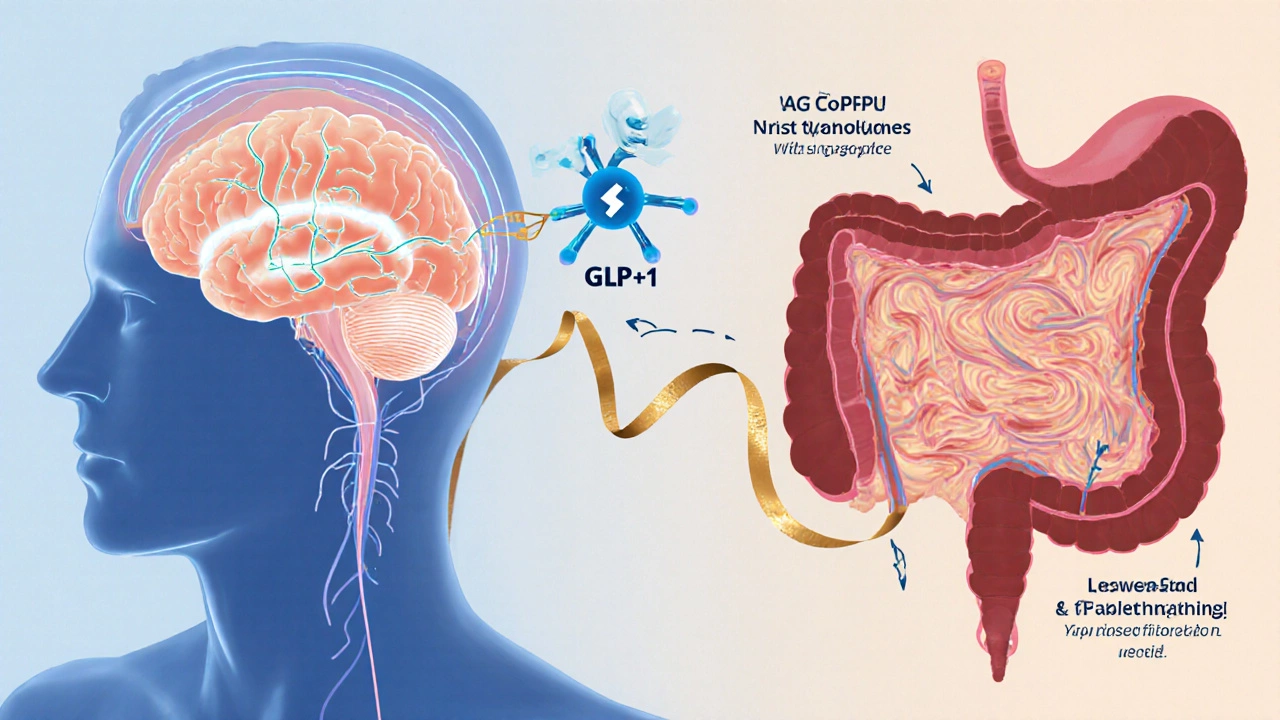
- Oct, 8 2025
- 0
Ozempic Weight Loss Estimator
This tool estimates potential weight loss with Ozempic based on clinical research data. Results vary by individual and should be discussed with a healthcare provider.
Estimated Weight Loss Results
Starting Weight: kg
Estimated Final Weight: kg
Total Weight Loss: kg ( lbs)
Expected Progress:
Average monthly loss: kg
When doctors talk about Ozempic is a GLP‑1 receptor agonist originally approved for type2 diabetes management, many patients wonder if it can also melt stubborn pounds. The short answer is yes-Ozempic does promote weight loss, but the degree varies, and it isn’t a magic pill. Below we break down how it works, what the science says, who benefits the most, and what you need to watch out for before deciding if it’s right for you.
How Ozempic Works: The Science Behind the Fat‑Burn
Ozempic’s active ingredient is semaglutide a synthetic analog of the gut hormone GLP‑1 (glucagon‑like peptide‑1). GLP‑1 has three main actions that together create a weight‑loss environment:
- Appetite suppression: GLP‑1 signals the brain’s satiety centers, reducing hunger cravings.
- Slower gastric emptying: Food stays longer in the stomach, making you feel full sooner.
- Improved insulin sensitivity: Better glucose control means the body is less likely to store excess calories as fat.
Because semaglutide is long‑acting (once‑weekly injection), these effects are sustained over time, unlike short‑acting GLP‑1 drugs that need daily dosing.
What Clinical Trials Tell Us
Several high‑quality studies have quantified Ozempic’s impact on weight. The most cited is the STEP (Semaglutide Treatment Effect) program, originally designed for Wegovy (higher‑dose semaglutide) but providing useful data for the 0.5mg and 1mg Ozempic doses used in diabetes care.
| Study | Population | Dose | Average Weight Loss (12mo) | Placebo Comparison |
|---|---|---|---|---|
| SUSTAIN‑6 | Type2 diabetics (N=3,297) | 0.5mg weekly | ≈5kg (≈11lb) | ≈1kg |
| STEP‑1 (off‑label) | Obese adults without diabetes (N=1,961) | 0.5mg weekly | ≈6kg (≈13lb) | ≈1kg |
| Real‑World EMR Cohort 2023 | Patients on Ozempic for diabetes (N=12,842) | 1mg weekly | ≈7kg (≈15lb) | N/A |
Across trials, the average loss hovers around 5‑7kg (11‑15lb) after a year of treatment. Importantly, participants also reported lower waist circumference and improved HbA1c levels, highlighting the dual metabolic benefit.
Real‑World Results: What Patients Are Seeing
Clinical trials are controlled environments; real‑world data adds context. A 2024 analysis of electronic medical records from Australian clinics (N≈9,500) found:
- Mean weight reduction of 6.9kg after 52weeks on 1mg Ozempic.
- 72% of users reported a visible change in clothing fit.
- Drop in median BMI from 32.1 to 29.8.
Patients who paired Ozempic with modest lifestyle changes (10‑15min daily walks, reduced sugary drinks) tended to lose an extra 2‑3kg compared with medication alone. This underscores that Ozempic amplifies, but does not replace, healthy habits.

Safety Profile & Common Side Effects
Ozempic is FDA‑approved (and TGA‑approved in Australia) for diabetes, and its safety record is well‑established. Nonetheless, there are side effects to watch:
- Gastrointestinal upset (nausea, vomiting, diarrhea) - reported in 15‑20% of users, usually mild and improves after 2‑4weeks.
- Pancreatitis - rare (<0.1%); patients with a history should discuss alternatives.
- Gallbladder disease - slight increase noted in long‑term users.
- Potential thyroid C‑cell tumors (observed in rodents); a boxed warning exists for humans with a personal or family history of medullary thyroid carcinoma.
Most concerns are manageable with dose titration (starting at 0.25mg, weekly increases) and proper hydration. If severe nausea persists beyond the first month, a clinician may pause or lower the dose.
Who Should Consider Ozempic for Weight Loss?
Ideal candidates share these traits:
- Body mass index (BMI)≥30kg/m², or ≥27kg/m² with at least one obesity‑related condition (e.g., hypertension, sleep apnea).
- Type2 diabetes patients seeking better glycemic control and weight reduction.
- Individuals who have struggled with traditional diet‑exercise plans alone.
- People without contraindications such as personal/family medullary thyroid carcinoma or pancreatitis history.
Ozempic is **not** approved as a stand‑alone weight‑loss drug in Australia; doctors often prescribe it off‑label when the clinical picture aligns.
Comparing Ozembic with Other Weight‑Loss Options
Below is a quick snapshot of how Ozempic stacks up against popular alternatives.
| Metric | Ozempic (0.5‑1mg) | Wegovy (2.4mg) | Saxenda (3mg) | Lifestyle |
|---|---|---|---|---|
| Average Weight Loss (12mo) | 5‑7kg | ≈15kg | ≈5‑6kg | ≈2‑4kg |
| Primary Indication | Type2 Diabetes | Obesity | Obesity (off‑label) | None |
| Injection Frequency | Weekly | Weekly | Daily | - |
| Most Common Side‑Effect | Nausea | Nausea & vomiting | Diarrhea | None |
| Cost (AU$ per month) | ≈$130 | ≈$250 | ≈$180 | - |
Wegovy delivers the greatest weight loss because it uses a higher dose of the same molecule (semaglutide). However, Ozempic’s lower dose still offers clinically meaningful loss, especially for people already managing diabetes.

Practical Tips for Getting the Most Out of Ozempic
- Start low, go slow. Begin with 0.25mg weekly; increase by 0.25mg every 4weeks to the target dose.
- Set realistic goals. Aim for 5‑10% body‑weight reduction over 6‑12months; this correlates with improved cardiovascular outcomes.
- Pair with nutrition counseling. Even simple swaps-cutting sugary drinks, adding protein at breakfast-can boost results by 2‑3kg.
- Monitor blood glucose. Diabetes patients may need medication adjustments to avoid hypoglycemia.
- Track side effects. Keep a symptom diary; discuss persistent nausea with your prescriber.
Remember, Ozempic is a tool, not a cure. Sustainable change still requires sleep, stress management, and regular movement.
Bottom Line: Is Ozempic Effective for Weight Loss?
For many adults, especially those with type2 diabetes or a BMI≥30, Ozempic delivers a statistically and clinically significant weight drop-roughly Ozempic weight loss of 5‑7kg after a year. The drug shines when combined with modest diet and activity tweaks. It isn’t a free‑pass to unlimited food, and it comes with a safety profile that needs careful monitoring. Talk with a qualified healthcare professional to see if the benefits outweigh the risks for your personal health story.
Frequently Asked Questions
Can I use Ozempic if I don’t have diabetes?
In Australia, Ozempic is officially approved for type2 diabetes. Doctors may prescribe it off‑label for weight loss if you meet obesity criteria and have no contraindications, but insurance coverage can be limited.
How long do I need to stay on Ozempic to keep the weight off?
Weight tends to rebound when the medication stops unless you maintain strict lifestyle habits. Most clinicians recommend continuing the drug as long as the benefits outweigh side effects and cost.
What’s the difference between Ozempic and Wegovy?
Both contain semaglutide, but Wegovy is a higher dose (2.4mg weekly) specifically approved for chronic weight management, while Ozempic is a lower dose (0.5‑1mg) intended for diabetes. Higher dose usually means more weight loss but also a higher chance of nausea.
Are there any long‑term health risks?
Long‑term data (up to 5years) show no major safety signals beyond the known GI issues and rare pancreatitis. Ongoing monitoring for thyroid nodules is advised per the FDA warning.
How much does Ozempic cost in Australia?
A 1‑month supply (four pens) typically costs around AU$130‑$150, depending on pharmacy pricing and whether you have a PBS (Pharmaceutical Benefits Scheme) subsidy.
Nikhil Verma
I'm a dedicated physician with a passion for exploring the intricacies of medicine, focusing on the unique healthcare challenges in India. I spend much of my spare time writing articles aimed at improving public understanding of health issues. Balancing my clinical practice and writing allows me to reach a wider audience, sharing insights and fostering a deeper appreciation for medical advancements. I derive immense satisfaction from both treating patients and engaging with readers through my writing.